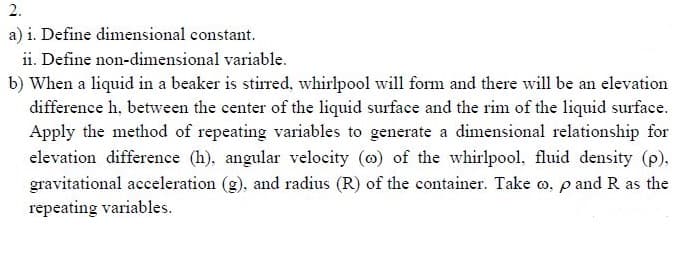a) i. Define dimensional constant. ii. Define non-dimensional variable. b) When a liquid in a beaker is stirred, whirlpool will form and there will be an elevation difference h, between the center of the liquid surface and the rim of the liquid surface. Apply the method of repeating variables to generate a dimensional relationship for elevation difference (h). angular velocity (@) of the whirlpool, fluid density (p). gravitational acceleration (g), and radius (R) of the container. Take o, p and R as the repeating variables.
a) i. Define dimensional constant. ii. Define non-dimensional variable. b) When a liquid in a beaker is stirred, whirlpool will form and there will be an elevation difference h, between the center of the liquid surface and the rim of the liquid surface. Apply the method of repeating variables to generate a dimensional relationship for elevation difference (h). angular velocity (@) of the whirlpool, fluid density (p). gravitational acceleration (g), and radius (R) of the container. Take o, p and R as the repeating variables.
Principles of Heat Transfer (Activate Learning with these NEW titles from Engineering!)
8th Edition
ISBN:9781305387102
Author:Kreith, Frank; Manglik, Raj M.
Publisher:Kreith, Frank; Manglik, Raj M.
Chapter5: Analysis Of Convection Heat Transfer
Section: Chapter Questions
Problem 5.8P
Related questions
Question

Transcribed Image Text:2.
a) i. Define dimensional constant.
ii. Define non-dimensional variable.
b) When a liquid in a beaker is stirred, whirlpool will form and there will be an elevation
difference h, between the center of the liquid surface and the rim of the liquid surface.
Apply the method of repeating variables to generate a dimensional relationship for
elevation difference (h), angular velocity (@) of the whirlpool, fluid density (p).
gravitational acceleration (g), and radius (R) of the container. Take o, p and R as the
repeating variables.
Expert Solution
This question has been solved!
Explore an expertly crafted, step-by-step solution for a thorough understanding of key concepts.
Step by step
Solved in 3 steps with 2 images

Knowledge Booster
Learn more about
Need a deep-dive on the concept behind this application? Look no further. Learn more about this topic, mechanical-engineering and related others by exploring similar questions and additional content below.Recommended textbooks for you

Principles of Heat Transfer (Activate Learning wi…
Mechanical Engineering
ISBN:
9781305387102
Author:
Kreith, Frank; Manglik, Raj M.
Publisher:
Cengage Learning

Principles of Heat Transfer (Activate Learning wi…
Mechanical Engineering
ISBN:
9781305387102
Author:
Kreith, Frank; Manglik, Raj M.
Publisher:
Cengage Learning